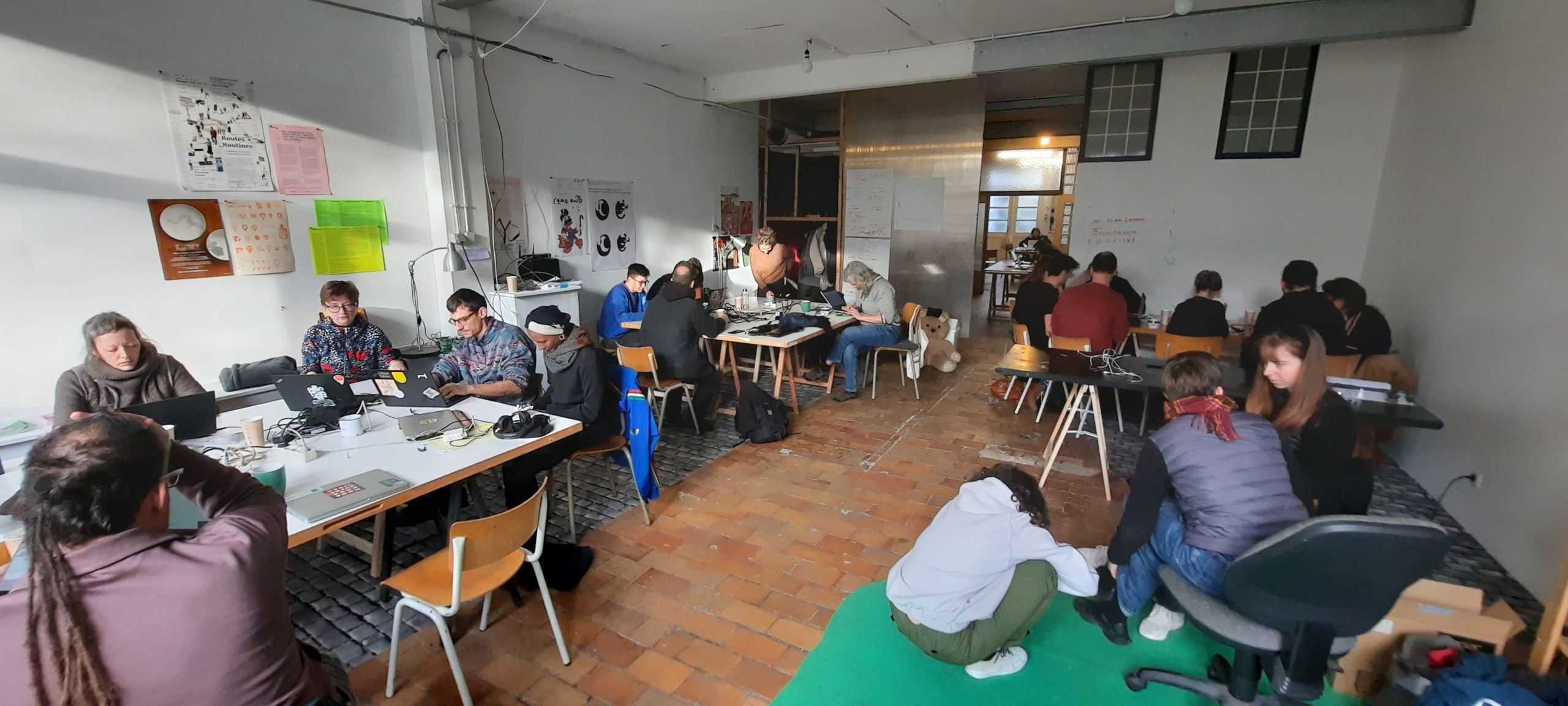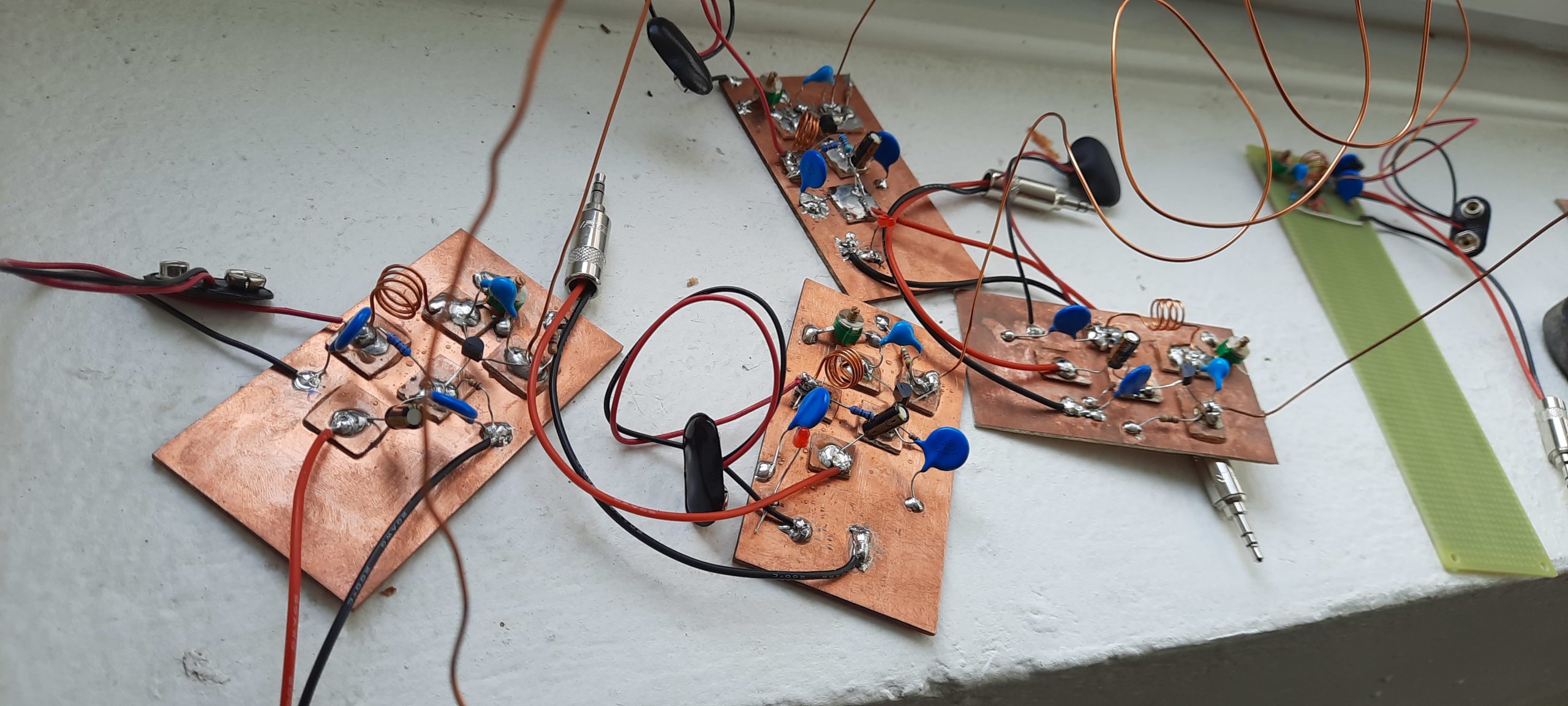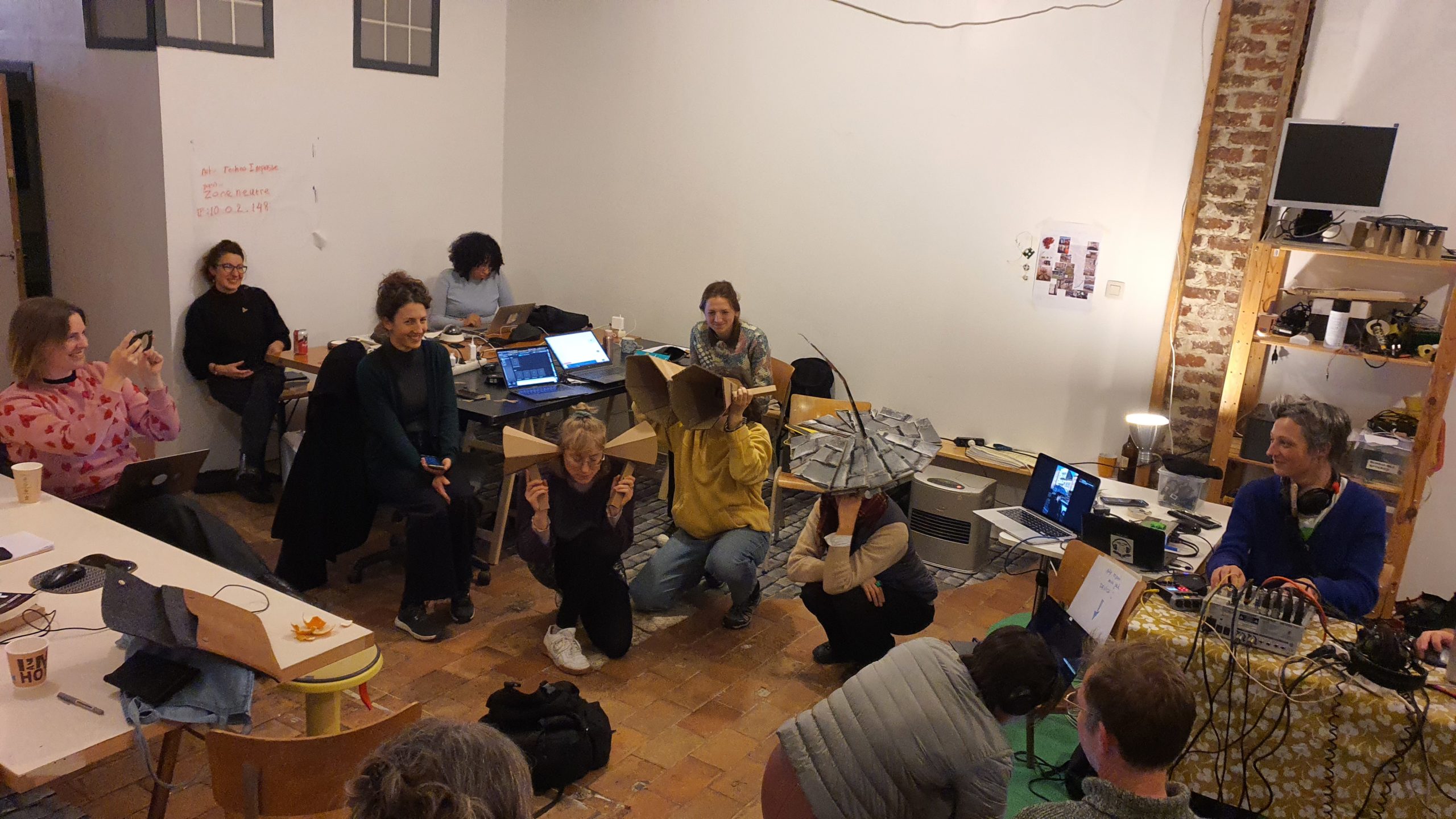Techno on the Radio: Constant’s Techno-Cul-de-Sac
Sumugan Sivanesan
December 2022
Constant’s recent worksession, Techno-Cul-de-Sac, co-convened by members Martino Morandi and Peter Westenberg (November 20–25, 2022), proposed a collective encounter with Brussels via an investigation of zoning, infrastructure, and technology, bringing together artists, architects, and urban researchers. I joined on the basis of my current artistic-research interest, fugitive radio, which seeks to develop collectively-realized modes of “performance-radio” using free and open-source tools. As such, I was particularly interested in zones determined by communication infrastructures: “network coverage, whether by cables or by the aether: phone lines, optical fibers, 4G, 5G, FM.” As someone engaged with interventions I was drawn to the worksession’s questions: What are possible strategies to express disagreement, temporarily or structurally in the urban space? As private property and public space melt into each other, what modes of dissent help us rethink public space and public action?
“Cul-de-sac” translates from French as “bottom of the bag.” Anatomically, it is associated with the coccyx and the ass, and it commonly refers to an enclosed road with a single passageway to enter and leave – a “dead end.” Over the week, I came to understand that we had arrived at a technological dead end as a function of platform capitalism: the rolling out of algorithmic surveillance, policing, and governance under the guise of convenience and novelty or as a necessity to meet failures and oversights in public infrastructure.

Techno-Cul-de-Sac worksession participants at work in Studio Techno-Cul.
Unsurprisingly, these top-down encroachments into urban life are not necessarily welcomed. Two days after the conclusion of Techno Cul-de-Sac, World Cup-induced riots broke out in central Brussels. Images of burning electric scooters circulating online were a sardonic reminder of OPENCOIL’s contributions to the worksession. Introducing themselves as “Scooter” and “Speedy,” Dennis de Bel and Anton Jehle’s collaboration investigates the emergence of micro-mobility – specifically, the sudden influx of hire-via-app electric scooters in cities including Berlin, Brussels, and Paris. Presented as a transport solution to “fill the gap” between public and private transport, de Bel and Jehle stumbled over these abandoned vehicles in Berlin and decided to follow their trail – back to the warehouses and garages where they would be recharged, repaired, and then redistributed by freelance “juicers” overnight. Treating these “e-scooters” as an urban resource, Scooter and Speedy began to devise hacks and “non-destructive add-ons” that would, for example, enable them to be used for charging devices, among other tricks. In October 2020, in the middle of the coronavirus pandemic, they organized the exhibition “OPEN COIL – A Roaming Speedshow” in Berlin, co-opting eleven randomly selected vehicles as their exhibition platform.
At a community and cultural space managed by Collectif CBO across the street from Constant’s workspace, OPENCOIL gave a public presentation with Thyl Van Gyzegem from Inter-Environment Bruxelles (IEB), an association of neighborhood groups involved in urban, social, and ecological struggles. Here the discussion pivoted around how the scooters were suddenly introduced into Brussels without community consultation and how they failed to service commuters who remained without reliable public transport beyond the central zones. They also failed to meet accessibility needs. Furthermore, the poor wages and working conditions of contractors hired to service the burgeoning micro-mobility sector and the fierce competition amongst players contributed to misgivings about these inconvenient interventions into public infrastructure and urban space. In their research, OPENCOIL found only two manufacturers of these scooters, located in China. With the advent of “Mobility as a Service” (MaaS) apps that integrate public and entrepreneurial transport options, many present felt that the micro-mobility sector’s real business was in gathering data for a handful of developers who were positioned to sell this on to interested parties. I spoke with an attendee about the possibility of “commoning” the e-scooters dumped on urban centers: Might they be repurposed as scooter-powered local meshworks?
The following night at Collectif CBO was a public screening of the recent documentary Livrer Bataille (2022) from ZIN TV, which concerns the struggle of food delivery couriers working for platforms such as Deliveroo and Uber Eats. In 2018, contracted Deliveroo riders were forced into freelancing and they responded by organizing strikes and actions across Belgium, France, Spain, and the UK. During the after-screening discussion, food couriers expressed how they were suspicious of unions and were instead founding their own collective spaces. We learned that these platforms exploit sans-papiers migrants and the racialized poor as “freelancers.” We were made aware of “dark kitchens” where many of these meals are prepared. It seems many in the hospitality industry believe food delivery apps are not a sustainable business model, considering the precarious conditions and high turnover of low-paid freelancers and the tight profit margins by which restaurants operate. Again, many believe the “real business” of these platforms is collecting data from both couriers and customers. We consider that even if couriers owned their data they may not be in a position to sell it. Could they use it to support their demands? The couriers believed the media was key to raising awareness and mobilizing their struggle. Exposing the precarious conditions of those who labor for consumer conveniences, Livrer Bataille displays platform capitalism’s data-biopower and social cost.
In another presentation, “Spectral Desire Paths,” the action research collective Urban Species reported on their ongoing project concerned with sensing, tracking, and consent as they relate to data-sharing and geo-positioning technology. The group utilizes a palm-sized, battery-powered “asset tracker” device designed by logistics company Sensolus. Proposing that people are more “susceptible” to giving their data to personified objects, the tracker was modified by affixing “friendly” googly eyes. A QR code completes the object’s “face,” which is then placed in public thoroughfares around Brussels. When intrigued passersby scan the code they are taken to a website (stripped of its IP address) where the device introduces itself as a “pet sensor” and asks to be adopted for a day, a week, or a month. The text suggests the finder take the tracker to their most “intimate places” where they may turn it upside down so that its eyes “will meet the sky.” Positioned so, the device can send GPS coordinates that are then plotted on a web-based map. Arguing that people are often unaware of how they are being surveilled in a city and are thus not afforded the choice to consent to such measures, Urban Species propose a way to make such operations and decisions more visible.
Another public workshop, Autodéfense numérique by Technopolice – which offered to “de-Google your phone” – began with the precaution that doing so would likely make one’s device unworkable, as many of the apps we regularly use – for example, for banking, shopping, and messaging – rely on the tech giant’s services. While we considered the conditions and effects of networked “convenience” and algorithmic governance, during Techno-Cul-de-Sac the street often returned as the site of politics and resistance. It may not be politically effective or advisable to become a mob, burning these imposed adversaries – if that is indeed what e-scooters, pet sensors, and smartphones are, as keepers of our most intimate information. Nevertheless, such novel technologies betray arrangements of capital and power in cities that aspire to be “smart” and incentivize start-up entrepreneurialism, which is arguably a condition of the (neo)liberalization of public services and the dismantling of the welfare state.
In response, Constant brings people together around technology and situated, embodied modes of research. I experienced Techno-Cul-de-Sac as a social practice as much as an artistic and activist inquiry. For example, the lunches were catered/curated by an enthusiastic duo of young chefs. Over the week, chefs Louis and Ollie delivered surprising soups, salads, and savory and sweet tortes with options that fulfilled the group’s dietary needs. When introduced, they shied away from our rousing, appreciative applause. They told us that their business was still fledgling and that they were cooking in their homes, drawing on their African heritage.

Techno-Cul-de-Sac worksession participants examine the view from Brusilia.
While the worksession was not about radio per se, radio was the medium that underpinned our activities. On our first afternoon together, we made a trip to Brusilia, a striking curved apartment block that is the second tallest residential building in Belgium and home to one of the participants. Next to the wide Josaphat Park, it stands alone in the Schaerbeek district of Brussels. Installed on the building’s rooftop are several antennae servicing different media and telecommunications organizations, including Radio Panik, a “free radio” initiative broadcasting since 1983 and emphasizing independence and diversity. Convening in a top-floor apartment, we reclined in a comfortable lounge room with tea and snacks, mingling with housemates and taking in the sweeping views across the city. Sound artist and researcher Stelios Manousakis delivered a concise explanation of frequencies cribbed from his PhD studies before we were briefed on an array of equipment scattered across the dining table. Then, in groups of three or four, we took turns climbing up the service stairs to the chilly rooftop. Wary of a coming storm, we roamed around the concrete platforms, absorbed in our scanning and recording devices amidst the wind and drizzle. Later, after we had returned to more comfortable surroundings, a discussion about experiences of “electrosensitivity” inevitably led to WifiCats.

DIY radio transmitters made with Radio Panik.
Techno-Cul-de-Sac culminated on Friday evening with an “Alleycasting” radio broadcast live on p-node, a decentralized community of servers, FM transmitters, and Digital Audio Broadcasting (DAB+) devices. As we finalized our projects – writing scripts, recording sound, editing and wrangling code – Susie from Radio Panik arranged a table in the middle of the workspace, installed a mixing desk, and arranged microphones. Constant member Wendy Van Wynsberghe began to play with electrosensitive sensors and a Kaoss Pad. Soon after, Stelios joined with his laptop with a USB frequency scanner attached, harvesting airborne signals that he then processed and sonified with software, while Peter allocated us each a time slot for the upcoming hour-long broadcast. As I have a particular interest in producing participatory forms of experimental radio, I was delighted by the way the event unfolded as we approached the mixing desk in turn, bringing our projects to the table to perform or play back.

Techno-Cul-de-Sac worksession “alleycasting” concluding event at Studio Techno-Cul, November 25, 2022.
While I spent much of the worksession struggling with unfamiliar software on my laptop, the emphasis of Techno-Cul-de-Sac was on the techno-social. With this and other worksessions, Constant makes a space to come together and (co-)work through issues that concern how technology shapes society and vice versa. Converging at the end of the road, we devise ways to push back – and make fun – given the appropriate (mental, physical, free and open source) tools.
Copyleft 2022 Constant, Techno-Cul-de-Sac worksession. You may copy, distribute, and modify this material according to the terms of the Collective Conditions for Re-Use (CC4r) 1.0.
Sumugan Sivanesan is an anti-disciplinary artist, researcher and writer. Often working collaboratively his interests span migrant histories and minority politics, activist media, artist infrastructures and more-than-human rights.